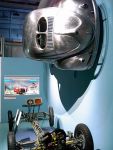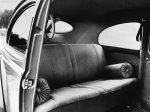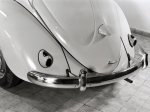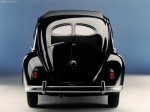From 1948, Volkswagen became a very important element, symbolically and economically, of West German regeneration. Heinrich Nordhoff (1899–1968), a former senior manager at Opel who had overseen civilian and military vehicle production in the 1930s and 1940s, was recruited to run the factory in 1948. In 1949 Major Hirst left association with the company, as it had now been re-formed as a trust, controlled by the West German government, and the government of the State of Lower Saxony. Apart from the introduction of the Volkswagen Type 2 commercial vehicle (van, pick-up and camper), and the VW Karmann Ghia sports car, Nordhoff pursued the one-model policy until shortly before his death in 1968.
Volkswagens were first exhibited and sold in the United States in 1949, but sold only two units in America that first year. On its entry to the U.S. market, the VW was briefly sold as a “Victory Wagon”. Volkswagen of America was formed in April 1955 to standardise sales and service in the United States. Production of the Type 1 Volkswagen Beetle increased dramatically over the years, the total reaching one million in 1955.
Volkswagens in Canada – Canadian Motors Limited brought in their first cars on 10 July 1952. (shipping order 143075) The order consisted of 12 vehicles, (3) model 11C, a black, green, and sandcolor (3) 11GS, a chestnut brown and two azure blue, (2) 24A-M51 in red, (1)21A in blue, (1) 23A in blue, (1) 22A beige color, and one Ambulance. Volkswagen Products were seen in Canada for the first time at the Canadian National Exhibition in August 1952 and were accepted enthusiastically. (at least one bus from this order still exists, currently in France undergoing restoration) The first shipment of cars for Volkswagen Canada reached Toronto in early December 1952. (at least one beetle from this first shipment still exists, travelled across Canada by VW Canada on their 60th Anniversary in 2012) By 1955 sales were on a basis that warranted the building of the fine Volkswagen plant on a 32-acre (130,000 m2) site on Scarboro’s Golden Mile. To this, a 60,000-square-foot (5,600 m2) building with administration, showrooms, service, repairs and parts, an addition of 60,000-square-foot (5,600 m2) was built in 1957, with storage for $4,000,000 of parts. (See 1959 Canadian Register of Commerce & Industry held in the Western Libraries at the University of Western Ontario, London, Ontario.)
Sales soared—thanks in part to the famous advertising campaigns by New York advertising agency Doyle, Dane Bernbach. Led by art director Helmut Krone, and copywriters Julian Koenig and Bob Levinson, Volkswagen advertisements became as popular as the car, using crisp layouts and witty copy to lure the younger, sophisticated consumers with whom the car became associated. Even though it was almost universally known as the Beetle (or the Bug), it was never officially labelled as such by the manufacturer, instead referred to as the Type 1.
Although the car was becoming outdated, during the 1960s and early 1970s, American exports, innovative advertising, and a growing reputation for reliability helped production figures surpass the levels of the previous record holder, the Ford Model T. On 17 February 1972 the 15,007,034th Beetle was sold. Volkswagen could now claim the world production record for the most-produced, single make of car in history. By 1973, total production was over 16 million.
To commemorate its passing the Ford Model T’s record sales mark and its victories in the Baja 1000 Mexican races from 1967 to 1971, Volkswagen produced its first limited-edition Beetle. It was marketed as the “Baja Champion SE” in the United States and the “Marathon” Superbeetle in the rest of the world. It featured unique “Marathon Blau” metallic blue paint, steel-pressed 10-spoke 15-inch (38 cm) magnesium-alloy wheels, a commemorative metal plate mounted on the glovebox and a certificate of authenticity presented to the original purchaser. Dealer-installed options for this limited-edition Superbeetle included the following: white stripes running the length of the rocker-panel, a special shifter knob, bumper overriders, tapered exhaust tips, fake walnut inserts in the dashboard (behind the steering wheel and the glovebox cover) as well as Bosch fog lights mounted on the front bumper.





